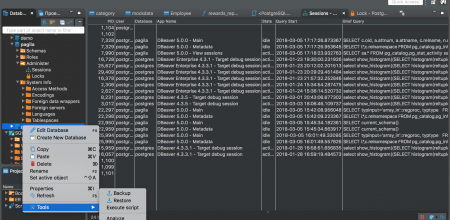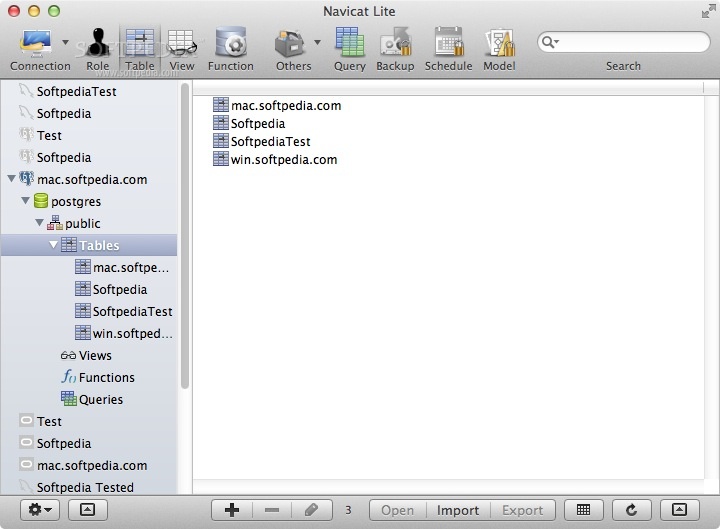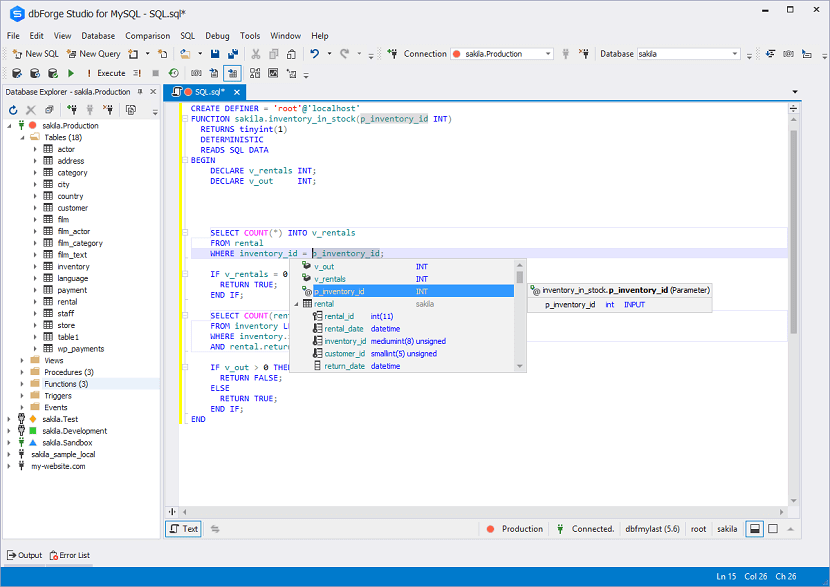Mysql Manager For Mac Os
MySQL for OS X is available in a number of different forms: Native Package Installer, which uses the native OS X installer (DMG) to walk you through the installation of MySQL. For more information, see Section 2.4.2, “Installing MySQL on OS X Using Native Packages”. Manager for macOS Download Purchase (also available on the Mac App Store) Download. SQLPro for MSSQL is the Premier application for editing and viewing SQL Server databases on mac os x. SQLPro for MSSQL. Download; Buy; A simple, powerful SQL Server manager for macOS. SQLPro for MySQL. SQLPro for SQLite. Feb 23, 2020 No official support for Mac OS. Price: Free #5 - dbForge Studio for MySQL. Pros: Comfortable user interface for both beginner and advanced users. Built in query profiler that allows to profile the query and compare it with other queries. Debug your query, step by step, using the known watch, call stack and breakpoint concepts.
The package is located inside a disk image (.dmg) file that you first need to mount by double-clicking its icon in the Finder. It should then mount the image and display its contents.

Before proceeding with the installation, be sure to stop all running MySQL server instances by using either the MySQL Manager Application (on macOS Server), the preference pane, or mysqladmin shutdown on the command line.
The current MySQL package for Mac OS X Mavericks (mysql-5.6.17-osx10.7-x8664 at the time of this writing) automatically creates a my.cnf during installation. It is located at /usr/local/mysql-5.6.17-osx10.7-x8664/my.cnf Adapt your path according to your version. MySQL for OS X is available in a number of different forms: Native Package Installer, which uses the native OS X installer (DMG) to walk you through the installation of MySQL. For more information, see Section 2.4.2, “Installing MySQL on OS X Using Native Packages”. You can use the package installer with OS X.
To install MySQL using the package installer:
Download the disk image (
.dmg) file (the community version is available here) that contains the MySQL package installer. Double-click the file to mount the disk image and see its contents.Figure 2.1 MySQL Package Installer: DMG Contents
Double-click the MySQL installer package from the disk. It is named according to the version of MySQL you have downloaded. For example, for MySQL server 5.7.33 it might be named
mysql-5.7.33-osx-.10.13-x86_64.pkgThe initial wizard introduction screen references the MySQL server version to install. Click to begin the installation.
Figure 2.2 MySQL Package Installer Wizard: Introduction
The MySQL community edition shows a copy of the relevant GNU General Public License. Click and then to continue.
From the Installation Type page you can either click to execute the installation wizard using all defaults, click to alter which components to install (MySQL server, Preference Pane, Launchd Support -- all enabled by default).
Although the option is visible, the installation location cannot be changed.
Figure 2.3 MySQL Package Installer Wizard: Installation Type
Figure 2.4 MySQL Package Installer Wizard: Customize
Click to begin the installation process.
After a successful installation, the installer displays a window with your temporary root password. This cannot be recovered so you must save this password for the initial login to MySQL. For example:
Figure 2.5 MySQL Package Installer Wizard: Temporary Root Password
MySQL expires this temporary root password after the initial login and requires you to create a new password.
Summary is the final step and references a successful and complete MySQL Server installation. the wizard.
Figure 2.6 MySQL Package Installer Wizard: Summary
MySQL server is now installed, but it is not loaded (or started) by default. Use either launchctl from the command line, or start MySQL by clicking 'Start' using the MySQL preference pane. For additional information, see Chapter 3, Installing a MySQL Launch Daemon, and Chapter 4, Installing and Using the MySQL Preference Pane. Use the MySQL Preference Pane or launchd to configure MySQL to automatically start at bootup.
When installing using the package installer, the files are installed into a directory within /usr/local matching the name of the installation version and platform. For example, the installer file mysql-5.7.33- installs MySQL into osx10.13-x86_64.dmg/usr/local/mysql-5.7.33-osx10.13-x86_64/ . The following table shows the layout of the installation directory.
Table 2.1 MySQL Installation Layout on macOS
| Directory | Contents of Directory |
|---|---|
bin | mysqld server, client and utility programs |
data | Log files, databases |
docs | Helper documents, like the Release Notes and build information |
include | Include (header) files |
lib | Libraries |
man | Unix manual pages |
mysql-test | MySQL test suite |
share | Miscellaneous support files, including error messages, sample configuration files, SQL for database installation |
support-files | Scripts and sample configuration files |
/tmp/mysql.sock | Location of the MySQL Unix socket |
During the package installer process, a symbolic link from /usr/local/mysql to the version/platform specific directory created during installation will be created automatically.

#1 - DBeaver
Pros:
- Multi-Platform Databases
- Intuitive and very easy to use user interface.
- Free to download, licensed under GPL.
- You can Render ERDs to visual your database
- Easy Import/Export/Backup
- Mock Data Generator
- NoSQL and BigData database support (Enterprise Edition Only)
- Visual Query Builder (Enterprise Edition Only)
- Analytical charts (Enterprise Edition Only)
- Query History (Enterprise Edition Only)
- Cross-platform - versions available for Windows, Linux and Mac OS.
- Easy way to export your schema and perform Automatic Database Tuning with EverSQL
Cons:
Click to start, for free.
- Sometimes large queries can’t be stopped and have to be forcefully killed. In some cases, the entire application has to be killed.
Price: Free for basic usage. Enterprise Edition starts at $199
#2 - DataGrip by JetBrain
Pros:
- Very fast auto-complete
- Plug-ins available - Large marketplace with many useful add-ons
- Notifications when long queries have completed
- Refactorings that work in SQL files and schemas - Enable you to change column names and perform mass updates
- Version control integration
- Multi-Platform Databases, Including MongoDB
- Built-in support for all popular databases
- Easy flow to download relevant drivers
- Diff viewer for routines
- Introspection - You can observe collections and fields in the database explorer.
- Cross-platform - versions available for Windows, Linux and Mac OS.
- Easy way to export your schema and perform Automatic Database Tuning with EverSQL
Cons:
- No Free version. Only 30 days trial
Price: Starts at $199.00
Click to start, for free.
#3 - MySQL Workbench
Pros:
- Intuitive and very easy to use user interface.
- Free to download, licensed under GPL.
- Cross platform - versions available for Windows, Linux and Mac OS.
- Visual schema and query builder.
- This is the only SQL client which is supported and developed by MySQL, so you can be sure that it will contain all recent features to match the updates for MySQL's server.
- Allows optimizing SQL queries directly from the IDE, using a plugin developed by EverSQL.
Cons:
- The software is sometimes buggy some users report software crashes.
- Sometimes large queries can’t be stopped and have to be forcefully killed. In some cases, the entire application has to be killed.
Price: Free.
#4 - HeidiSQL
Pros:
- Easy to use and very intuitive user interface.
- Free to use - Licensed under GNU GPL.
- Portable version is available for download, so you can use it without administrative privileges, nor requiring installation.
- Full database user management and privileges management options.
- Automate connections via command line utility.
- Ability to connect to MySQL database via an SSH tunnel, in case you don’t have the default port open for remote connections.
- Great syntax checks and auto completion features.
- Can work with Linux distributions, but will require the Wine platform
Cons:
Click to start, for free.
- Some users are reporting sudden crashes / bugs, but nothing that significantly interrupts the daily usage.
- Requires Wine for Linux.
- No official support for Mac OS.
Price: Free
#5 - dbForge Studio for MySQL
Pros:
- Comfortable user interface for both beginner and advanced users.
- Built in query profiler that allows to profile the query and compare it with other queries.
- Debug your query, step by step, using the known watch, call stack and breakpoint concepts.
- GUI query builder and database builder. Drag and drop to build your own custom queries and database schema.
- Good syntax completion and checker.
- Full database user management and privileges management options.
- Backup wizard that allows to schedule database backups.
- Allows storing code snippets.
- Good support for running large SQL files (without opening them).
Cons:
- The full version has a high price tag on it, so not everyone will be able to afford it.
- Very basic JSON viewer (for example, no ways to collapse or expand blocks of data).
- Users report that in some cases the auto complete feature stops working, whenever many connections are opened.
Mysql Manager Mac Os X
Price: up to $249.95.
#6 - Navicat for MySQL
Pros:
- Intuitive, easy to use UI.
- Ability to connect to MySQL database via an SSH tunnel, in case you don’t have the default port open for remote connections.
- Schedule database jobs - backup, restore, run reports and more.
- Import data from: ODBC, Excel, Access, DBF, TXT, CSV, XML, JSON.
- Export data to: Excel, Access, DBF, TXT, CSV, XML, JSON.
- Visual schema and query builders.
- Cross platform - Windows, Linux and Mac OS versions are available.
- Syntax completion and checker.
- The premium version allows collaboration with team mates - share queries, connections and more.
Cons:

- High price point for the professional version.
- Uses Wine to be executed on Linux, which slows down the IDE.
- Some of the use cases require opening a new tab / window, which users report as a cumbersome process.
Price: up to $259.
#7 - SQLyog
Click to start, for free.
Pros:
- Very innovative and elegant user interface, best one we’ve seen.
- Visually design the schema tables, constraints and queries.
- Schedule tasks like backup, restore, email notifications and more.
- Personalize the look and feel with themes.
- The user interface is very customize-able.
- Fast and stable.
- Good data and schema sync tools.
- Ability to connect to MySQL database via an SSH tunnel, in case you don’t have the default port open for remote connections.
- The Ultimate version comes with a good data comparison tool.
Cons:
Mysql Manager For Mac Os 10.14

- High price point for the professional version.
- Some users report occasional software crashes.
- Lack of support for databases other than MySQL.
- No native support for Linux or Mac.
- No drag and drop support between multiple tabs.
Mysql Manager For Mac Os 10.10
Price: Up to $299.
